Benefits of 3D Printing in Manufacturing
VerifiedAdded on 2020/04/07
|10
|2240
|221
AI Summary
This assignment examines the advantages of 3D printing technology within the manufacturing industry. It delves into how 3D printing enhances efficiency by reducing production time, minimizing material waste, and enabling rapid prototyping. The text also discusses the impact of 3D printing on mass customization, allowing for tailored products at a reduced cost.
Contribute Materials
Your contribution can guide someone’s learning journey. Share your
documents today.
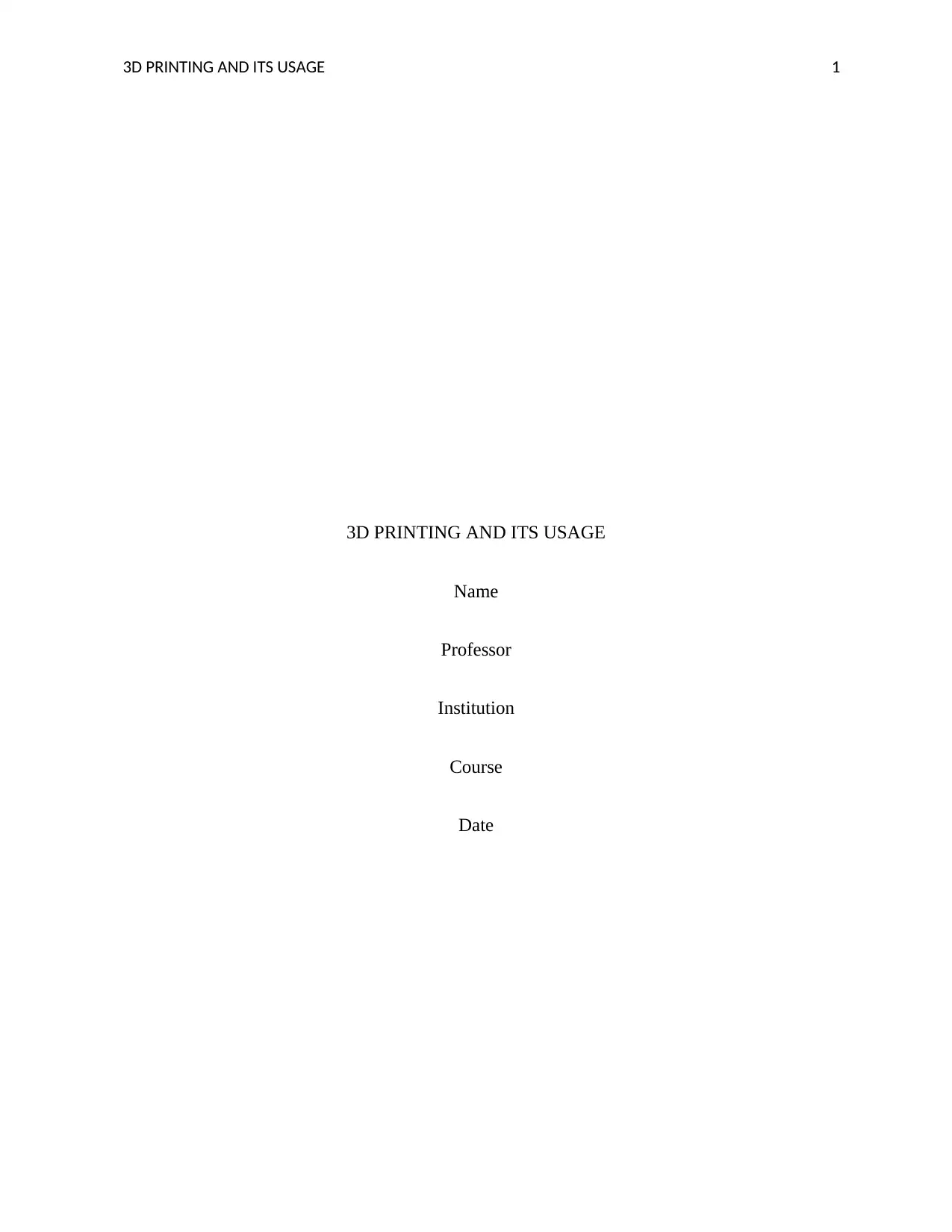
3D PRINTING AND ITS USAGE 1
3D PRINTING AND ITS USAGE
Name
Professor
Institution
Course
Date
3D PRINTING AND ITS USAGE
Name
Professor
Institution
Course
Date
Secure Best Marks with AI Grader
Need help grading? Try our AI Grader for instant feedback on your assignments.
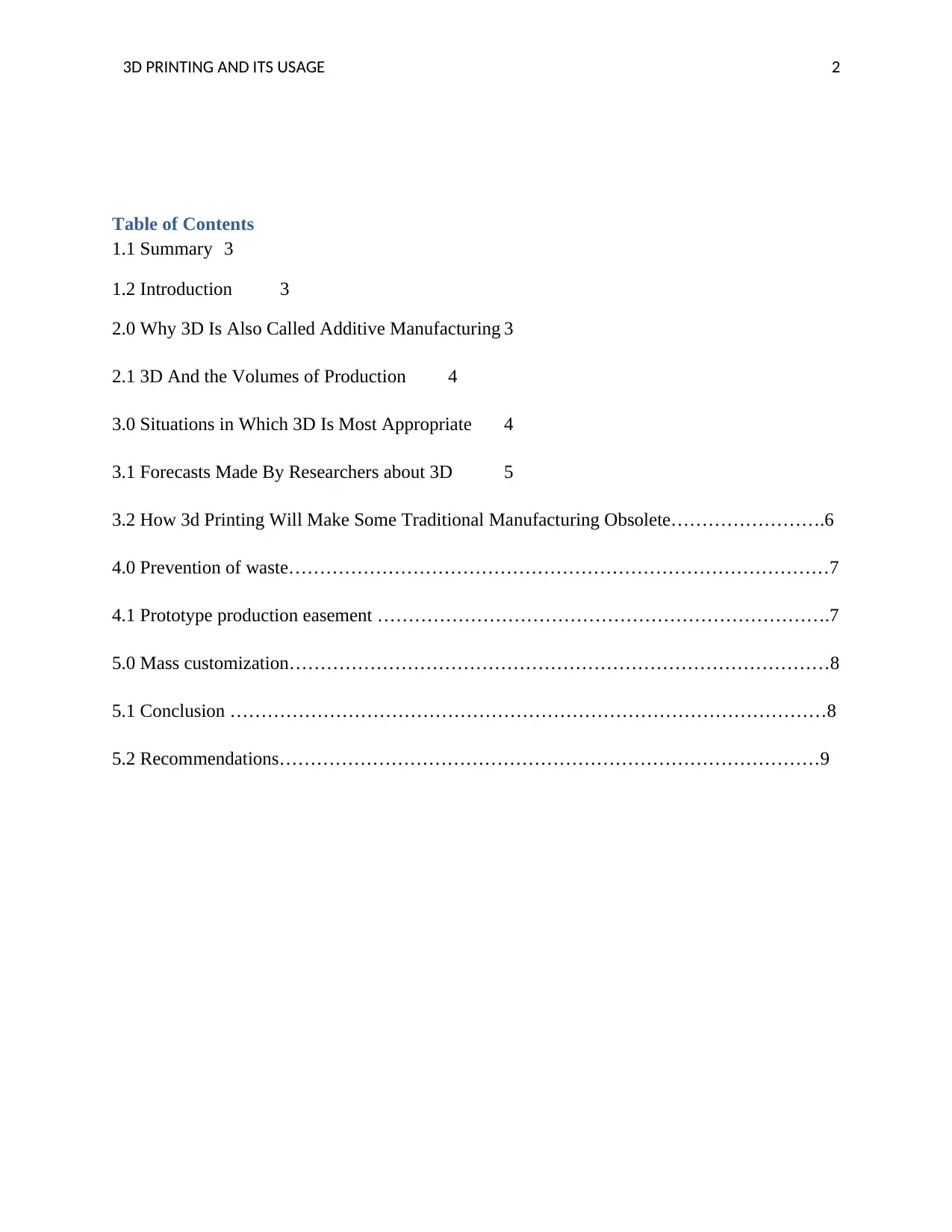
3D PRINTING AND ITS USAGE 2
Table of Contents
1.1 Summary 3
1.2 Introduction 3
2.0 Why 3D Is Also Called Additive Manufacturing 3
2.1 3D And the Volumes of Production 4
3.0 Situations in Which 3D Is Most Appropriate 4
3.1 Forecasts Made By Researchers about 3D 5
3.2 How 3d Printing Will Make Some Traditional Manufacturing Obsolete…………………….6
4.0 Prevention of waste……………………………………………………………………………7
4.1 Prototype production easement ……………………………………………………………….7
5.0 Mass customization……………………………………………………………………………8
5.1 Conclusion ……………………………………………………………………………………8
5.2 Recommendations……………………………………………………………………………9
Table of Contents
1.1 Summary 3
1.2 Introduction 3
2.0 Why 3D Is Also Called Additive Manufacturing 3
2.1 3D And the Volumes of Production 4
3.0 Situations in Which 3D Is Most Appropriate 4
3.1 Forecasts Made By Researchers about 3D 5
3.2 How 3d Printing Will Make Some Traditional Manufacturing Obsolete…………………….6
4.0 Prevention of waste……………………………………………………………………………7
4.1 Prototype production easement ……………………………………………………………….7
5.0 Mass customization……………………………………………………………………………8
5.1 Conclusion ……………………………………………………………………………………8
5.2 Recommendations……………………………………………………………………………9
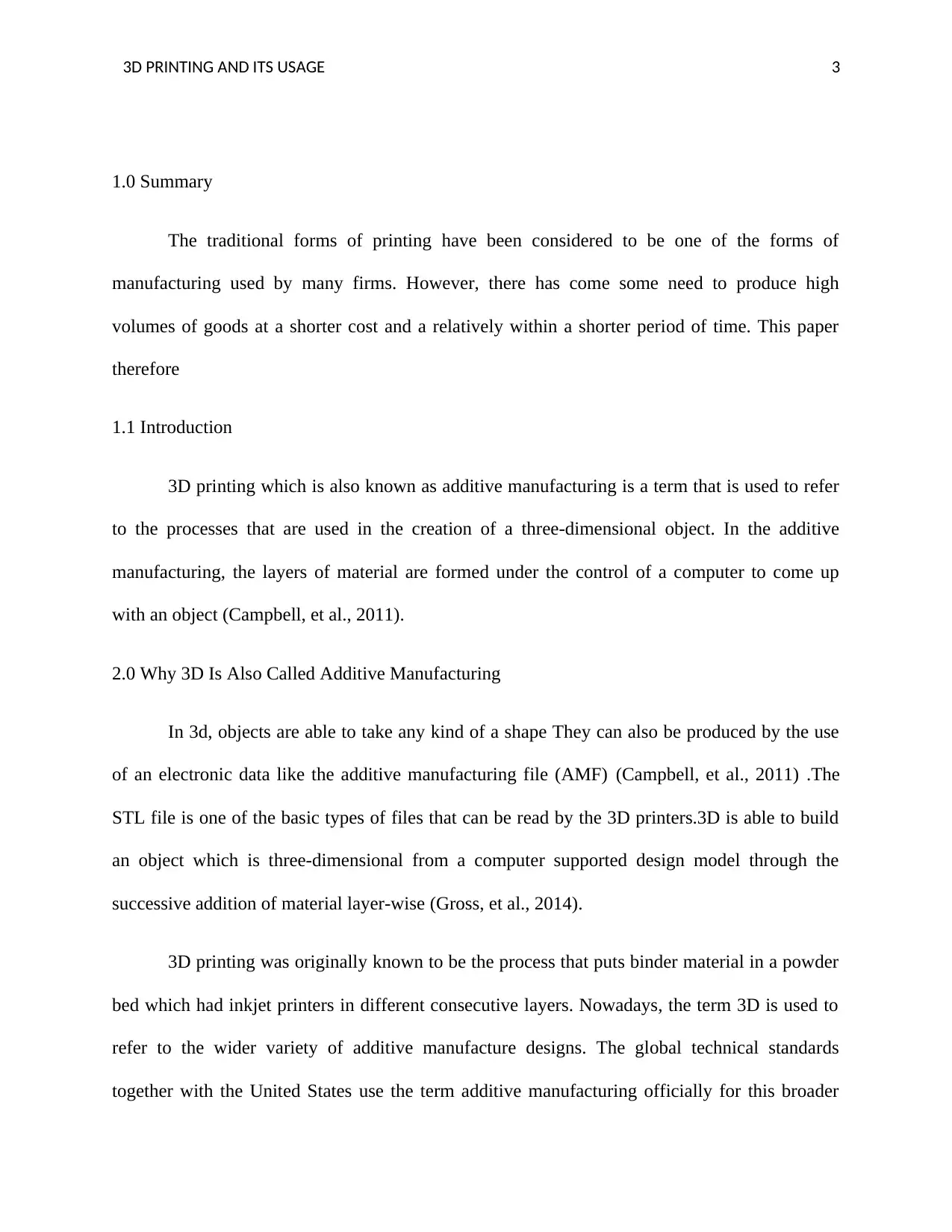
3D PRINTING AND ITS USAGE 3
1.0 Summary
The traditional forms of printing have been considered to be one of the forms of
manufacturing used by many firms. However, there has come some need to produce high
volumes of goods at a shorter cost and a relatively within a shorter period of time. This paper
therefore
1.1 Introduction
3D printing which is also known as additive manufacturing is a term that is used to refer
to the processes that are used in the creation of a three-dimensional object. In the additive
manufacturing, the layers of material are formed under the control of a computer to come up
with an object (Campbell, et al., 2011).
2.0 Why 3D Is Also Called Additive Manufacturing
In 3d, objects are able to take any kind of a shape They can also be produced by the use
of an electronic data like the additive manufacturing file (AMF) (Campbell, et al., 2011) .The
STL file is one of the basic types of files that can be read by the 3D printers.3D is able to build
an object which is three-dimensional from a computer supported design model through the
successive addition of material layer-wise (Gross, et al., 2014).
3D printing was originally known to be the process that puts binder material in a powder
bed which had inkjet printers in different consecutive layers. Nowadays, the term 3D is used to
refer to the wider variety of additive manufacture designs. The global technical standards
together with the United States use the term additive manufacturing officially for this broader
1.0 Summary
The traditional forms of printing have been considered to be one of the forms of
manufacturing used by many firms. However, there has come some need to produce high
volumes of goods at a shorter cost and a relatively within a shorter period of time. This paper
therefore
1.1 Introduction
3D printing which is also known as additive manufacturing is a term that is used to refer
to the processes that are used in the creation of a three-dimensional object. In the additive
manufacturing, the layers of material are formed under the control of a computer to come up
with an object (Campbell, et al., 2011).
2.0 Why 3D Is Also Called Additive Manufacturing
In 3d, objects are able to take any kind of a shape They can also be produced by the use
of an electronic data like the additive manufacturing file (AMF) (Campbell, et al., 2011) .The
STL file is one of the basic types of files that can be read by the 3D printers.3D is able to build
an object which is three-dimensional from a computer supported design model through the
successive addition of material layer-wise (Gross, et al., 2014).
3D printing was originally known to be the process that puts binder material in a powder
bed which had inkjet printers in different consecutive layers. Nowadays, the term 3D is used to
refer to the wider variety of additive manufacture designs. The global technical standards
together with the United States use the term additive manufacturing officially for this broader
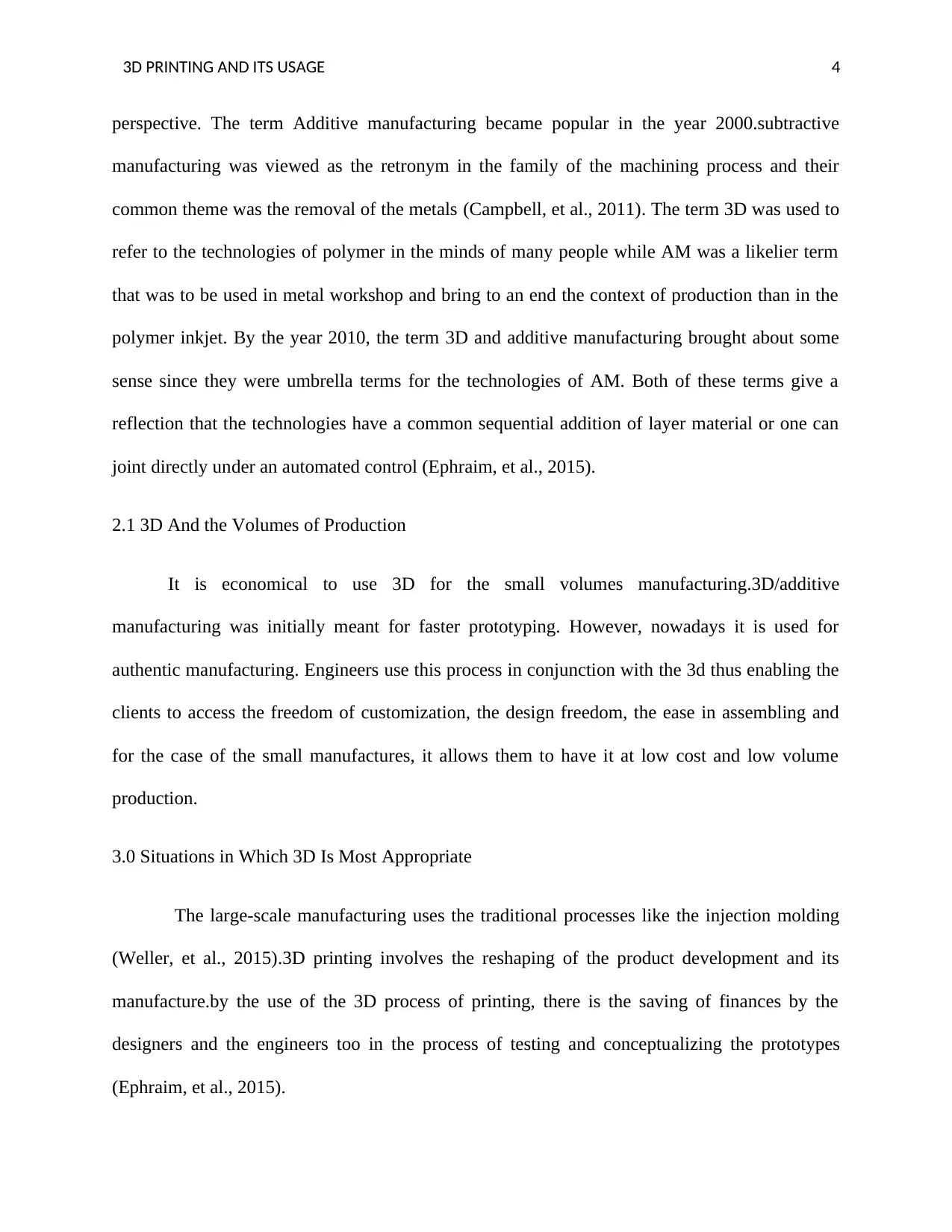
3D PRINTING AND ITS USAGE 4
perspective. The term Additive manufacturing became popular in the year 2000.subtractive
manufacturing was viewed as the retronym in the family of the machining process and their
common theme was the removal of the metals (Campbell, et al., 2011). The term 3D was used to
refer to the technologies of polymer in the minds of many people while AM was a likelier term
that was to be used in metal workshop and bring to an end the context of production than in the
polymer inkjet. By the year 2010, the term 3D and additive manufacturing brought about some
sense since they were umbrella terms for the technologies of AM. Both of these terms give a
reflection that the technologies have a common sequential addition of layer material or one can
joint directly under an automated control (Ephraim, et al., 2015).
2.1 3D And the Volumes of Production
It is economical to use 3D for the small volumes manufacturing.3D/additive
manufacturing was initially meant for faster prototyping. However, nowadays it is used for
authentic manufacturing. Engineers use this process in conjunction with the 3d thus enabling the
clients to access the freedom of customization, the design freedom, the ease in assembling and
for the case of the small manufactures, it allows them to have it at low cost and low volume
production.
3.0 Situations in Which 3D Is Most Appropriate
The large-scale manufacturing uses the traditional processes like the injection molding
(Weller, et al., 2015).3D printing involves the reshaping of the product development and its
manufacture.by the use of the 3D process of printing, there is the saving of finances by the
designers and the engineers too in the process of testing and conceptualizing the prototypes
(Ephraim, et al., 2015).
perspective. The term Additive manufacturing became popular in the year 2000.subtractive
manufacturing was viewed as the retronym in the family of the machining process and their
common theme was the removal of the metals (Campbell, et al., 2011). The term 3D was used to
refer to the technologies of polymer in the minds of many people while AM was a likelier term
that was to be used in metal workshop and bring to an end the context of production than in the
polymer inkjet. By the year 2010, the term 3D and additive manufacturing brought about some
sense since they were umbrella terms for the technologies of AM. Both of these terms give a
reflection that the technologies have a common sequential addition of layer material or one can
joint directly under an automated control (Ephraim, et al., 2015).
2.1 3D And the Volumes of Production
It is economical to use 3D for the small volumes manufacturing.3D/additive
manufacturing was initially meant for faster prototyping. However, nowadays it is used for
authentic manufacturing. Engineers use this process in conjunction with the 3d thus enabling the
clients to access the freedom of customization, the design freedom, the ease in assembling and
for the case of the small manufactures, it allows them to have it at low cost and low volume
production.
3.0 Situations in Which 3D Is Most Appropriate
The large-scale manufacturing uses the traditional processes like the injection molding
(Weller, et al., 2015).3D printing involves the reshaping of the product development and its
manufacture.by the use of the 3D process of printing, there is the saving of finances by the
designers and the engineers too in the process of testing and conceptualizing the prototypes
(Ephraim, et al., 2015).
Secure Best Marks with AI Grader
Need help grading? Try our AI Grader for instant feedback on your assignments.
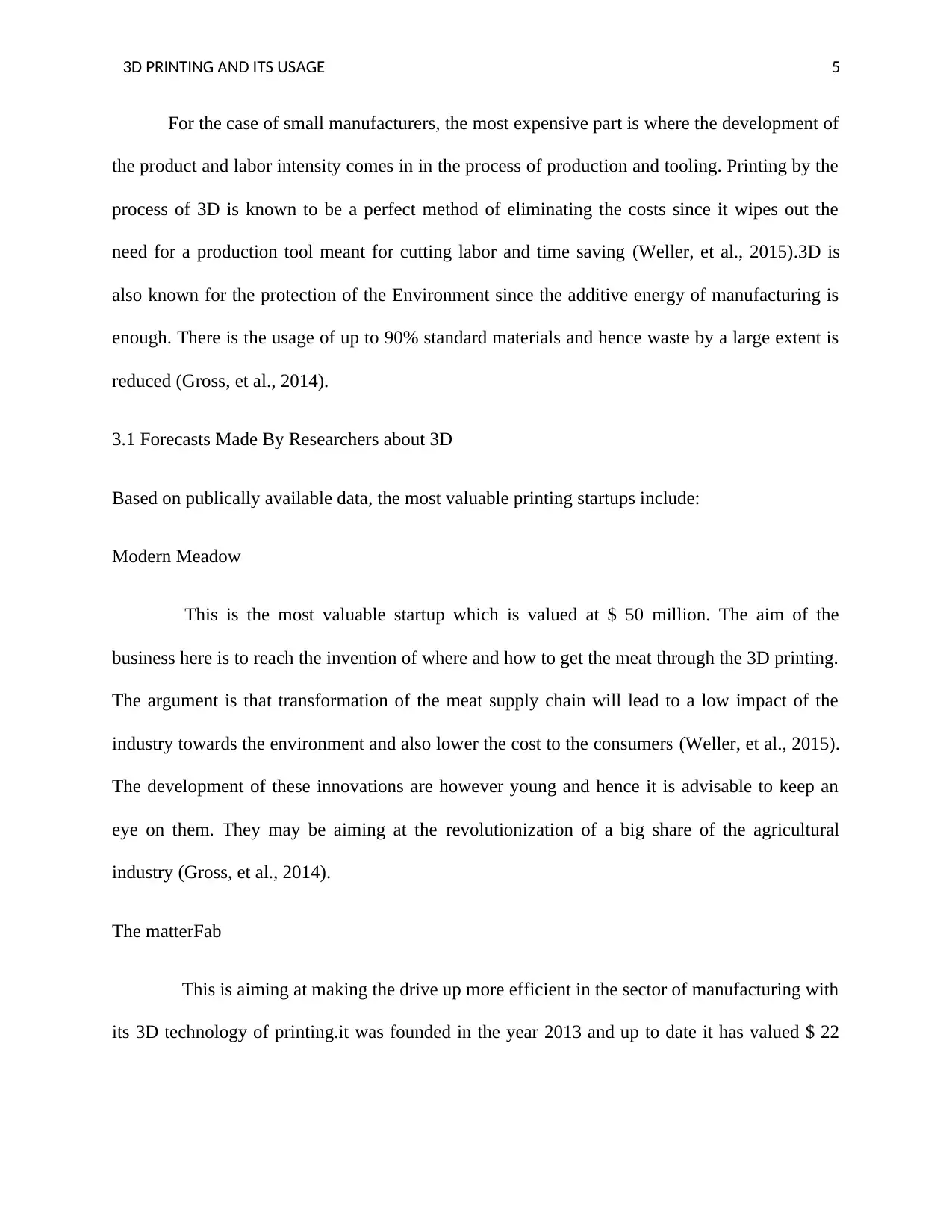
3D PRINTING AND ITS USAGE 5
For the case of small manufacturers, the most expensive part is where the development of
the product and labor intensity comes in in the process of production and tooling. Printing by the
process of 3D is known to be a perfect method of eliminating the costs since it wipes out the
need for a production tool meant for cutting labor and time saving (Weller, et al., 2015).3D is
also known for the protection of the Environment since the additive energy of manufacturing is
enough. There is the usage of up to 90% standard materials and hence waste by a large extent is
reduced (Gross, et al., 2014).
3.1 Forecasts Made By Researchers about 3D
Based on publically available data, the most valuable printing startups include:
Modern Meadow
This is the most valuable startup which is valued at $ 50 million. The aim of the
business here is to reach the invention of where and how to get the meat through the 3D printing.
The argument is that transformation of the meat supply chain will lead to a low impact of the
industry towards the environment and also lower the cost to the consumers (Weller, et al., 2015).
The development of these innovations are however young and hence it is advisable to keep an
eye on them. They may be aiming at the revolutionization of a big share of the agricultural
industry (Gross, et al., 2014).
The matterFab
This is aiming at making the drive up more efficient in the sector of manufacturing with
its 3D technology of printing.it was founded in the year 2013 and up to date it has valued $ 22
For the case of small manufacturers, the most expensive part is where the development of
the product and labor intensity comes in in the process of production and tooling. Printing by the
process of 3D is known to be a perfect method of eliminating the costs since it wipes out the
need for a production tool meant for cutting labor and time saving (Weller, et al., 2015).3D is
also known for the protection of the Environment since the additive energy of manufacturing is
enough. There is the usage of up to 90% standard materials and hence waste by a large extent is
reduced (Gross, et al., 2014).
3.1 Forecasts Made By Researchers about 3D
Based on publically available data, the most valuable printing startups include:
Modern Meadow
This is the most valuable startup which is valued at $ 50 million. The aim of the
business here is to reach the invention of where and how to get the meat through the 3D printing.
The argument is that transformation of the meat supply chain will lead to a low impact of the
industry towards the environment and also lower the cost to the consumers (Weller, et al., 2015).
The development of these innovations are however young and hence it is advisable to keep an
eye on them. They may be aiming at the revolutionization of a big share of the agricultural
industry (Gross, et al., 2014).
The matterFab
This is aiming at making the drive up more efficient in the sector of manufacturing with
its 3D technology of printing.it was founded in the year 2013 and up to date it has valued $ 22
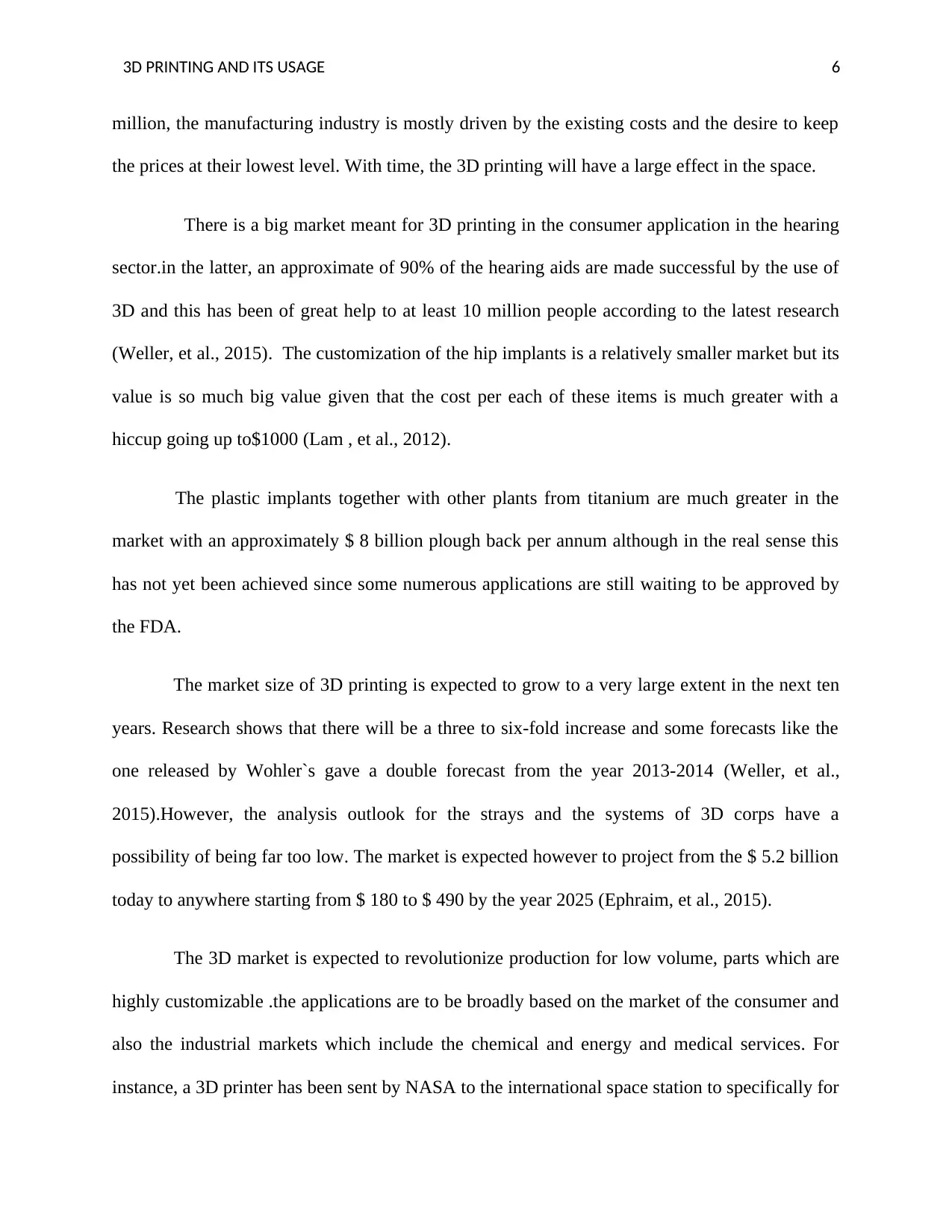
3D PRINTING AND ITS USAGE 6
million, the manufacturing industry is mostly driven by the existing costs and the desire to keep
the prices at their lowest level. With time, the 3D printing will have a large effect in the space.
There is a big market meant for 3D printing in the consumer application in the hearing
sector.in the latter, an approximate of 90% of the hearing aids are made successful by the use of
3D and this has been of great help to at least 10 million people according to the latest research
(Weller, et al., 2015). The customization of the hip implants is a relatively smaller market but its
value is so much big value given that the cost per each of these items is much greater with a
hiccup going up to$1000 (Lam , et al., 2012).
The plastic implants together with other plants from titanium are much greater in the
market with an approximately $ 8 billion plough back per annum although in the real sense this
has not yet been achieved since some numerous applications are still waiting to be approved by
the FDA.
The market size of 3D printing is expected to grow to a very large extent in the next ten
years. Research shows that there will be a three to six-fold increase and some forecasts like the
one released by Wohler`s gave a double forecast from the year 2013-2014 (Weller, et al.,
2015).However, the analysis outlook for the strays and the systems of 3D corps have a
possibility of being far too low. The market is expected however to project from the $ 5.2 billion
today to anywhere starting from $ 180 to $ 490 by the year 2025 (Ephraim, et al., 2015).
The 3D market is expected to revolutionize production for low volume, parts which are
highly customizable .the applications are to be broadly based on the market of the consumer and
also the industrial markets which include the chemical and energy and medical services. For
instance, a 3D printer has been sent by NASA to the international space station to specifically for
million, the manufacturing industry is mostly driven by the existing costs and the desire to keep
the prices at their lowest level. With time, the 3D printing will have a large effect in the space.
There is a big market meant for 3D printing in the consumer application in the hearing
sector.in the latter, an approximate of 90% of the hearing aids are made successful by the use of
3D and this has been of great help to at least 10 million people according to the latest research
(Weller, et al., 2015). The customization of the hip implants is a relatively smaller market but its
value is so much big value given that the cost per each of these items is much greater with a
hiccup going up to$1000 (Lam , et al., 2012).
The plastic implants together with other plants from titanium are much greater in the
market with an approximately $ 8 billion plough back per annum although in the real sense this
has not yet been achieved since some numerous applications are still waiting to be approved by
the FDA.
The market size of 3D printing is expected to grow to a very large extent in the next ten
years. Research shows that there will be a three to six-fold increase and some forecasts like the
one released by Wohler`s gave a double forecast from the year 2013-2014 (Weller, et al.,
2015).However, the analysis outlook for the strays and the systems of 3D corps have a
possibility of being far too low. The market is expected however to project from the $ 5.2 billion
today to anywhere starting from $ 180 to $ 490 by the year 2025 (Ephraim, et al., 2015).
The 3D market is expected to revolutionize production for low volume, parts which are
highly customizable .the applications are to be broadly based on the market of the consumer and
also the industrial markets which include the chemical and energy and medical services. For
instance, a 3D printer has been sent by NASA to the international space station to specifically for
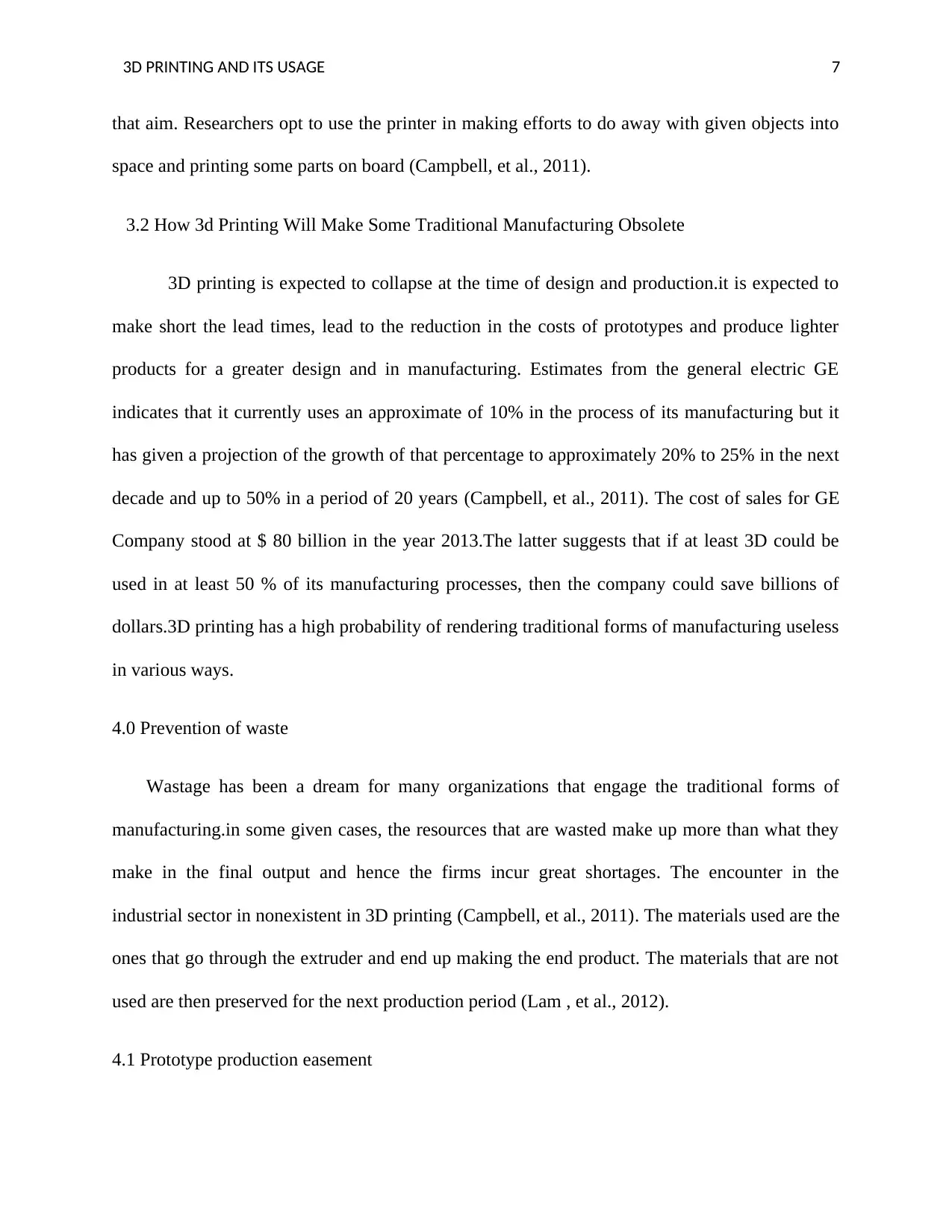
3D PRINTING AND ITS USAGE 7
that aim. Researchers opt to use the printer in making efforts to do away with given objects into
space and printing some parts on board (Campbell, et al., 2011).
3.2 How 3d Printing Will Make Some Traditional Manufacturing Obsolete
3D printing is expected to collapse at the time of design and production.it is expected to
make short the lead times, lead to the reduction in the costs of prototypes and produce lighter
products for a greater design and in manufacturing. Estimates from the general electric GE
indicates that it currently uses an approximate of 10% in the process of its manufacturing but it
has given a projection of the growth of that percentage to approximately 20% to 25% in the next
decade and up to 50% in a period of 20 years (Campbell, et al., 2011). The cost of sales for GE
Company stood at $ 80 billion in the year 2013.The latter suggests that if at least 3D could be
used in at least 50 % of its manufacturing processes, then the company could save billions of
dollars.3D printing has a high probability of rendering traditional forms of manufacturing useless
in various ways.
4.0 Prevention of waste
Wastage has been a dream for many organizations that engage the traditional forms of
manufacturing.in some given cases, the resources that are wasted make up more than what they
make in the final output and hence the firms incur great shortages. The encounter in the
industrial sector in nonexistent in 3D printing (Campbell, et al., 2011). The materials used are the
ones that go through the extruder and end up making the end product. The materials that are not
used are then preserved for the next production period (Lam , et al., 2012).
4.1 Prototype production easement
that aim. Researchers opt to use the printer in making efforts to do away with given objects into
space and printing some parts on board (Campbell, et al., 2011).
3.2 How 3d Printing Will Make Some Traditional Manufacturing Obsolete
3D printing is expected to collapse at the time of design and production.it is expected to
make short the lead times, lead to the reduction in the costs of prototypes and produce lighter
products for a greater design and in manufacturing. Estimates from the general electric GE
indicates that it currently uses an approximate of 10% in the process of its manufacturing but it
has given a projection of the growth of that percentage to approximately 20% to 25% in the next
decade and up to 50% in a period of 20 years (Campbell, et al., 2011). The cost of sales for GE
Company stood at $ 80 billion in the year 2013.The latter suggests that if at least 3D could be
used in at least 50 % of its manufacturing processes, then the company could save billions of
dollars.3D printing has a high probability of rendering traditional forms of manufacturing useless
in various ways.
4.0 Prevention of waste
Wastage has been a dream for many organizations that engage the traditional forms of
manufacturing.in some given cases, the resources that are wasted make up more than what they
make in the final output and hence the firms incur great shortages. The encounter in the
industrial sector in nonexistent in 3D printing (Campbell, et al., 2011). The materials used are the
ones that go through the extruder and end up making the end product. The materials that are not
used are then preserved for the next production period (Lam , et al., 2012).
4.1 Prototype production easement
Paraphrase This Document
Need a fresh take? Get an instant paraphrase of this document with our AI Paraphraser
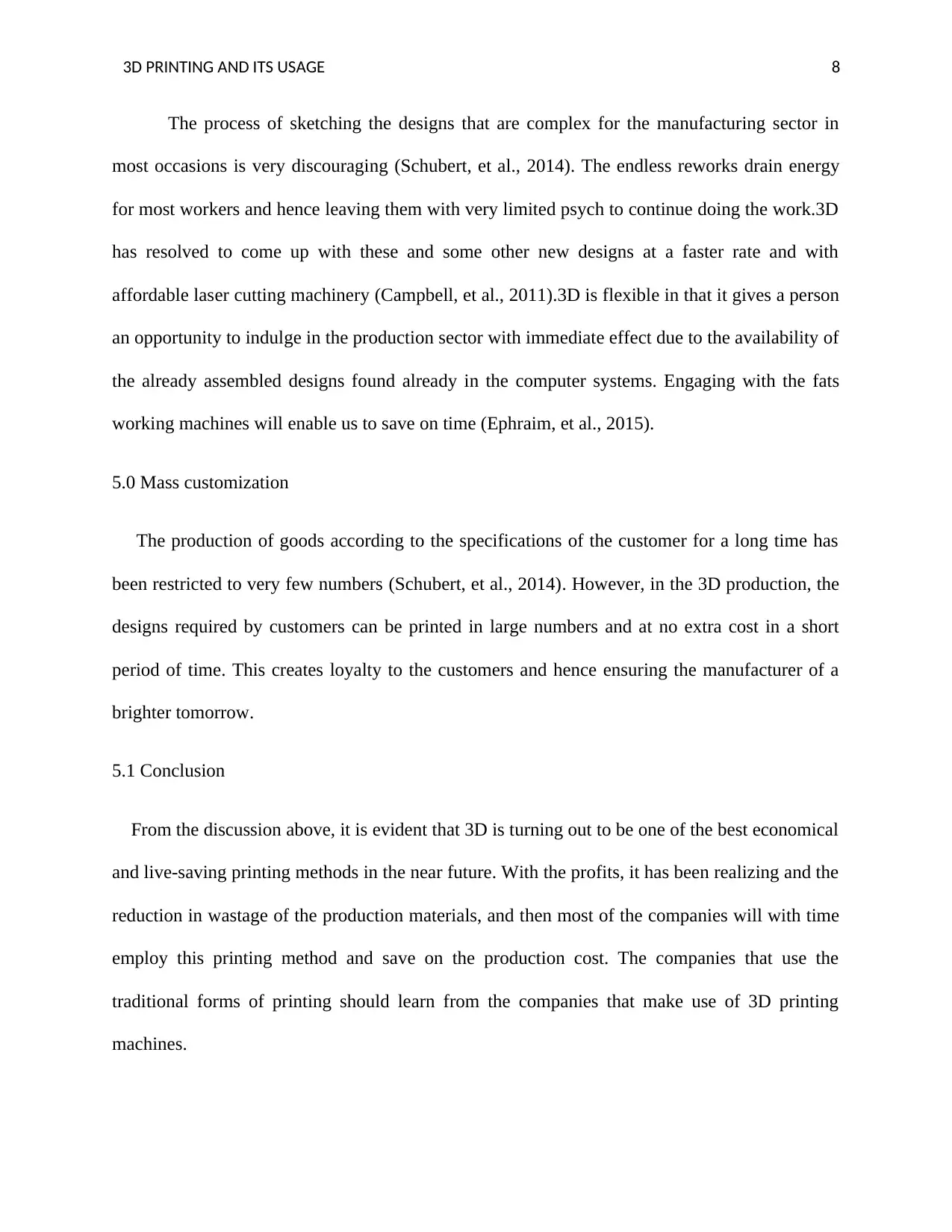
3D PRINTING AND ITS USAGE 8
The process of sketching the designs that are complex for the manufacturing sector in
most occasions is very discouraging (Schubert, et al., 2014). The endless reworks drain energy
for most workers and hence leaving them with very limited psych to continue doing the work.3D
has resolved to come up with these and some other new designs at a faster rate and with
affordable laser cutting machinery (Campbell, et al., 2011).3D is flexible in that it gives a person
an opportunity to indulge in the production sector with immediate effect due to the availability of
the already assembled designs found already in the computer systems. Engaging with the fats
working machines will enable us to save on time (Ephraim, et al., 2015).
5.0 Mass customization
The production of goods according to the specifications of the customer for a long time has
been restricted to very few numbers (Schubert, et al., 2014). However, in the 3D production, the
designs required by customers can be printed in large numbers and at no extra cost in a short
period of time. This creates loyalty to the customers and hence ensuring the manufacturer of a
brighter tomorrow.
5.1 Conclusion
From the discussion above, it is evident that 3D is turning out to be one of the best economical
and live-saving printing methods in the near future. With the profits, it has been realizing and the
reduction in wastage of the production materials, and then most of the companies will with time
employ this printing method and save on the production cost. The companies that use the
traditional forms of printing should learn from the companies that make use of 3D printing
machines.
The process of sketching the designs that are complex for the manufacturing sector in
most occasions is very discouraging (Schubert, et al., 2014). The endless reworks drain energy
for most workers and hence leaving them with very limited psych to continue doing the work.3D
has resolved to come up with these and some other new designs at a faster rate and with
affordable laser cutting machinery (Campbell, et al., 2011).3D is flexible in that it gives a person
an opportunity to indulge in the production sector with immediate effect due to the availability of
the already assembled designs found already in the computer systems. Engaging with the fats
working machines will enable us to save on time (Ephraim, et al., 2015).
5.0 Mass customization
The production of goods according to the specifications of the customer for a long time has
been restricted to very few numbers (Schubert, et al., 2014). However, in the 3D production, the
designs required by customers can be printed in large numbers and at no extra cost in a short
period of time. This creates loyalty to the customers and hence ensuring the manufacturer of a
brighter tomorrow.
5.1 Conclusion
From the discussion above, it is evident that 3D is turning out to be one of the best economical
and live-saving printing methods in the near future. With the profits, it has been realizing and the
reduction in wastage of the production materials, and then most of the companies will with time
employ this printing method and save on the production cost. The companies that use the
traditional forms of printing should learn from the companies that make use of 3D printing
machines.
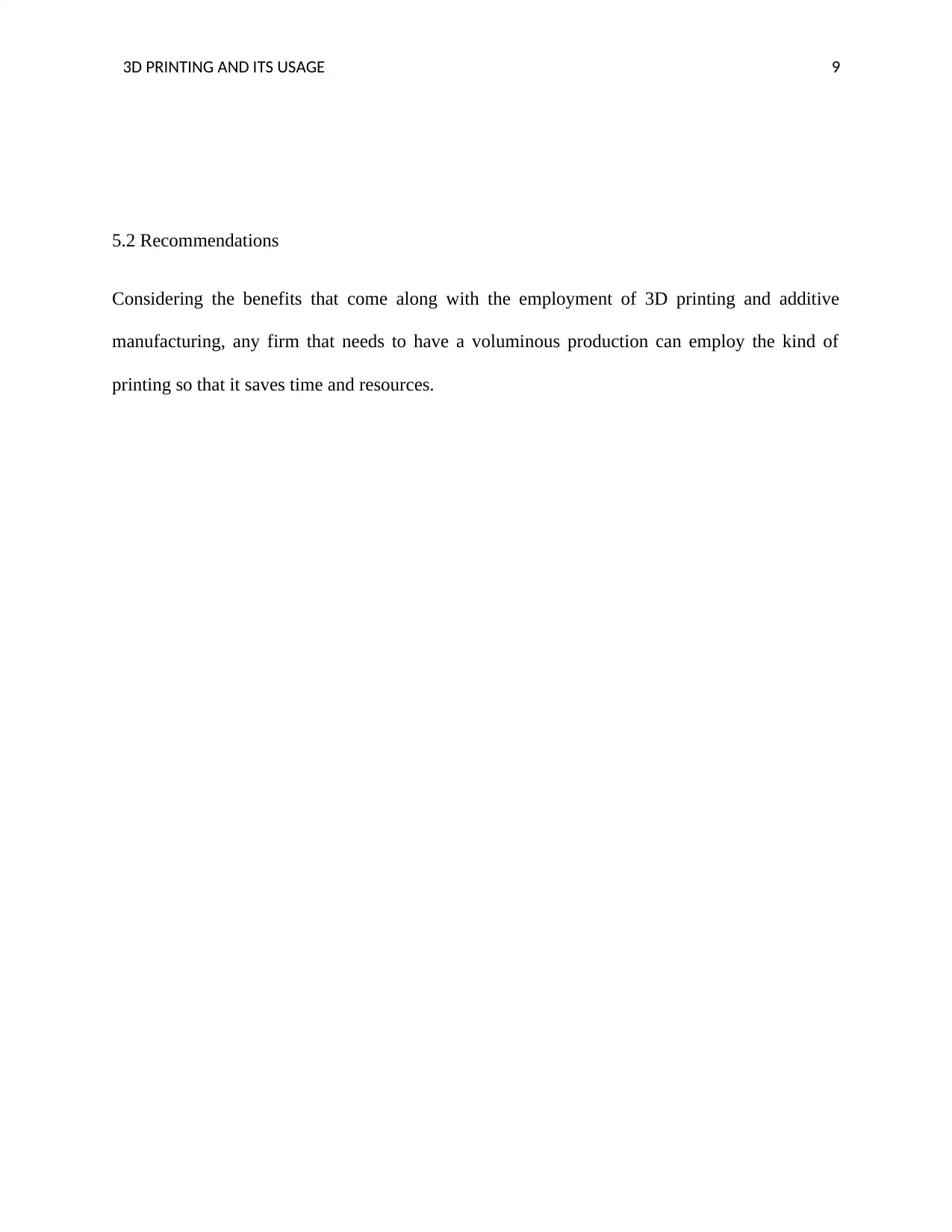
3D PRINTING AND ITS USAGE 9
5.2 Recommendations
Considering the benefits that come along with the employment of 3D printing and additive
manufacturing, any firm that needs to have a voluminous production can employ the kind of
printing so that it saves time and resources.
5.2 Recommendations
Considering the benefits that come along with the employment of 3D printing and additive
manufacturing, any firm that needs to have a voluminous production can employ the kind of
printing so that it saves time and resources.
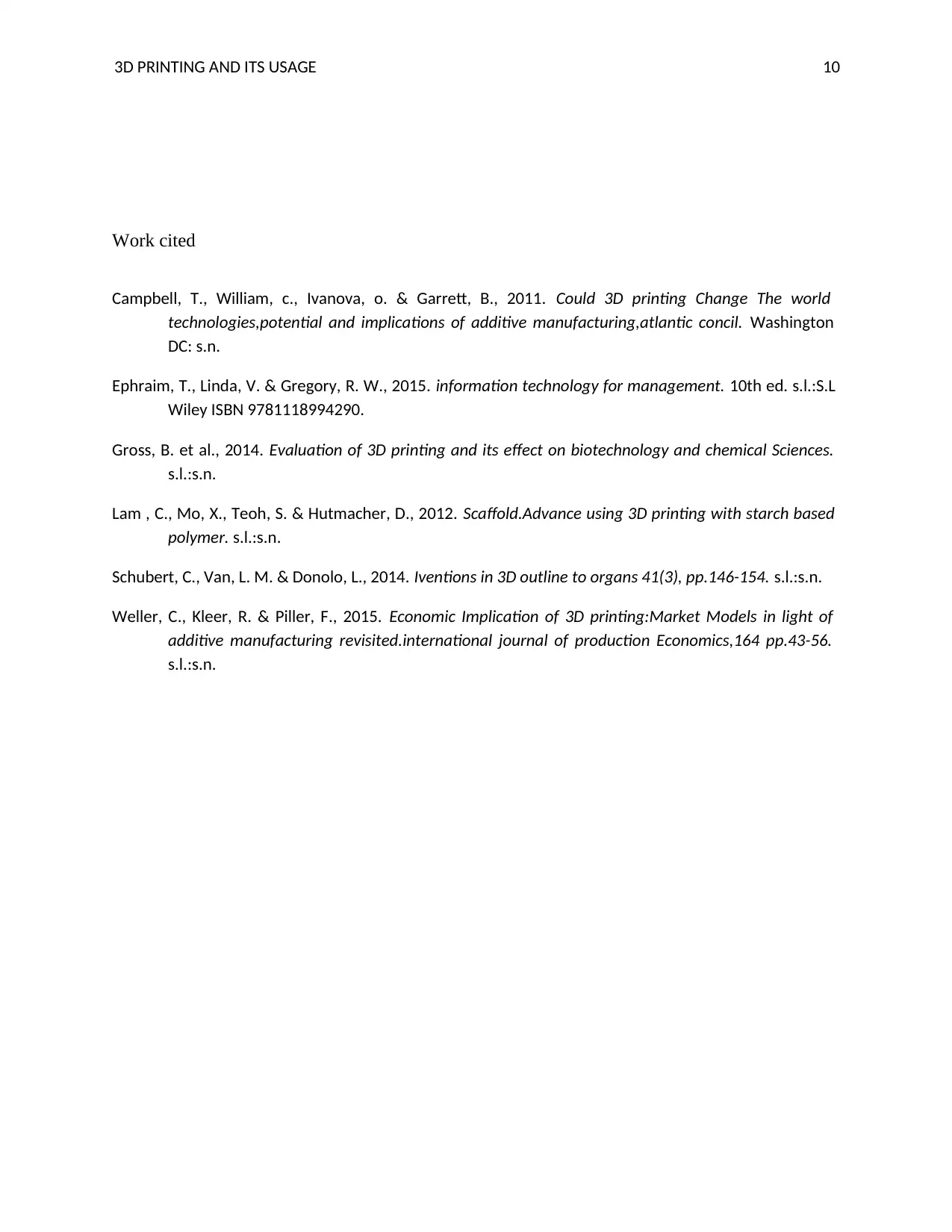
3D PRINTING AND ITS USAGE 10
Work cited
Campbell, T., William, c., Ivanova, o. & Garrett, B., 2011. Could 3D printing Change The world
technologies,potential and implications of additive manufacturing,atlantic concil. Washington
DC: s.n.
Ephraim, T., Linda, V. & Gregory, R. W., 2015. information technology for management. 10th ed. s.l.:S.L
Wiley ISBN 9781118994290.
Gross, B. et al., 2014. Evaluation of 3D printing and its effect on biotechnology and chemical Sciences.
s.l.:s.n.
Lam , C., Mo, X., Teoh, S. & Hutmacher, D., 2012. Scaffold.Advance using 3D printing with starch based
polymer. s.l.:s.n.
Schubert, C., Van, L. M. & Donolo, L., 2014. Iventions in 3D outline to organs 41(3), pp.146-154. s.l.:s.n.
Weller, C., Kleer, R. & Piller, F., 2015. Economic Implication of 3D printing:Market Models in light of
additive manufacturing revisited.international journal of production Economics,164 pp.43-56.
s.l.:s.n.
Work cited
Campbell, T., William, c., Ivanova, o. & Garrett, B., 2011. Could 3D printing Change The world
technologies,potential and implications of additive manufacturing,atlantic concil. Washington
DC: s.n.
Ephraim, T., Linda, V. & Gregory, R. W., 2015. information technology for management. 10th ed. s.l.:S.L
Wiley ISBN 9781118994290.
Gross, B. et al., 2014. Evaluation of 3D printing and its effect on biotechnology and chemical Sciences.
s.l.:s.n.
Lam , C., Mo, X., Teoh, S. & Hutmacher, D., 2012. Scaffold.Advance using 3D printing with starch based
polymer. s.l.:s.n.
Schubert, C., Van, L. M. & Donolo, L., 2014. Iventions in 3D outline to organs 41(3), pp.146-154. s.l.:s.n.
Weller, C., Kleer, R. & Piller, F., 2015. Economic Implication of 3D printing:Market Models in light of
additive manufacturing revisited.international journal of production Economics,164 pp.43-56.
s.l.:s.n.
1 out of 10
Related Documents
Your All-in-One AI-Powered Toolkit for Academic Success.
+13062052269
info@desklib.com
Available 24*7 on WhatsApp / Email
![[object Object]](/_next/static/media/star-bottom.7253800d.svg)
Unlock your academic potential
© 2024 | Zucol Services PVT LTD | All rights reserved.





